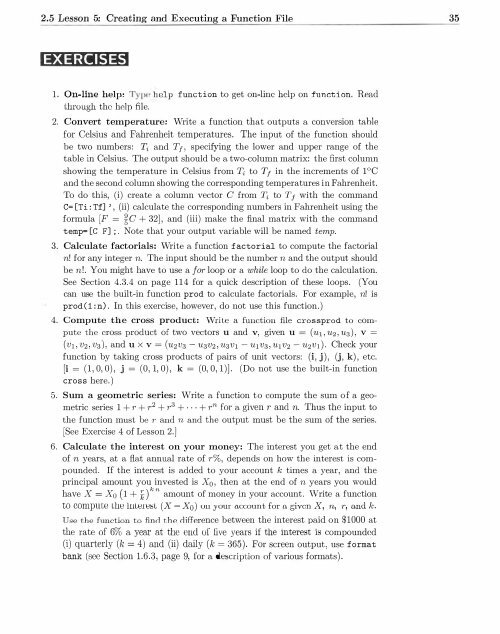You also want an ePaper? Increase the reach of your titles
YUMPU automatically turns print PDFs into web optimized ePapers that Google loves.
2.5 Lesson 5: Creating and Executing a Function File<br />
35<br />
EXERCISES<br />
1. On-line help: Type help function to get on-line help on function. Read<br />
through the help file.<br />
2. Convert temp erature : Write a function that outputs a conversion table<br />
for Celsius and Fahrenheit temperatures. The input of the function should<br />
be two numbers: Ti and Tf , specifying the lower and upper range of the<br />
table in Celsius. The output should be a two-column matrix: the first column<br />
showing the temperature in Celsius from Ti to T1 in the increments of 1 oc<br />
and the second column showing the corresponding temperatures in Fahrenheit.<br />
To do this, (i) create a column vector C from Ti to T1 with the command<br />
C= [Ti : Tf] ' , (ii) calculate the corresponding numbers in Fahrenheit using the<br />
formula [F = tC + 32], and (iii) make the final matrix with the command<br />
temp= [C F] ; . Note that your output variable will be named temp.<br />
3. Calculate factorials: Write a function factorial to compute the factorial<br />
n! for any integer n. The input should be the number n and the output should<br />
be n!. You might have to use a for loop or a while loop to do the calculation.<br />
See Section 4.3.4 on page 114 for a quick description of these loops. (You<br />
can use the built-in function prod to calculate factorials. For example, n! is<br />
prod ( 1 : n) . In this exercise, however, do not use this function.)<br />
4. Compute the cross product: Write a function file crossprod to compute<br />
the cross product of two vectors u and v, given u = (u1 , u2 , u3) , v =<br />
(v1,v2,v3), and u x v = (u2v3 - u3 v2, u3 v1 - u1v3, u 1 v2 - u2v1) . Check your<br />
function <strong>by</strong> taking cross products of pairs of unit vectors: (i, j), (j , k), etc.<br />
[i = (1, 0, 0), j = (0, 1, 0), k = (0, 0, 1)]. (Do not use the built-in function<br />
cross here.)<br />
5. Sum a geometric series: Write a function to compute the sum of a geometric<br />
series 1 + r + r 2 + r3 + · · · + rn for a given r and n. Thus the input to<br />
the function must be r and n and the output must be the sum of the series.<br />
[See Exercise 4 of Lesson 2.]<br />
6. Calculate the interest on your money: The interest you get at the end<br />
of n years, at a fiat annual rate of r%, depends on how the interest is compounded.<br />
If the interest is added to your account k times a year, and the<br />
principal amount you invested is X0 , then at the end of n years you would<br />
have X = Xo (1 + );:)kn amount of money in your account. Write a function<br />
to compute the iuLeresL (X - Xo) on your account for t1 given X, n, r, and k.<br />
Use the fnnction to fin



